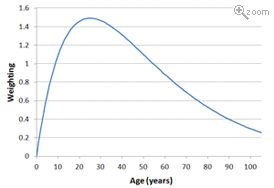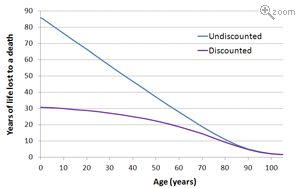Age weighting and discounting
Prior to 2010, the GBD estimates differentially weighted the DALYs attributed to each age group to recognise the disproportionate contribution made to society by young adults. The weights were scaled to leave total DALYs unchanged.
Note that, even if one weights the estimates by age, the death of an infant still leads to more YLL than a death at any other age because that infant loses an entire lifetime, including the highly-valued years of life that he or she might have lived as a young adult.
In addition, prior to 2010, the main set of estimates of the future loss of healthy life resulting from disease episodes and deaths occurring in the base year was discounted at 3 per cent a year so that healthy life lost in the future was valued less than healthy life lost in the present day.
Discounting the future benefits of investment projects is standard practice in cost-effectiveness and cost-benefit analysis but controversial in the health field. Various arguments exist in favour of it, the most persuasive of which are the research and eradication paradoxes. These point out that, because the future benefits of research and of eradicating diseases are virtually infinite, if one does not discount the future benefits from either activity relative to the immediate benefits of other investments, one ought to invest 100 per cent of health expenditure in either research or eradication programmes.

